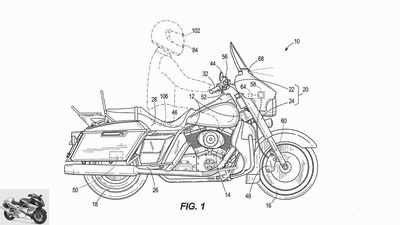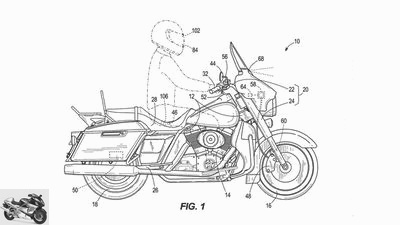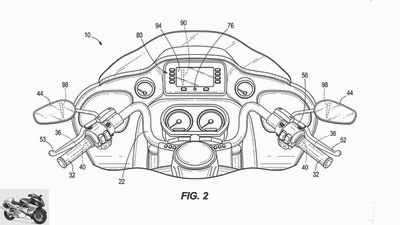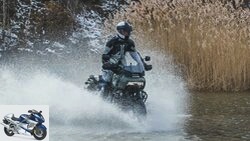Table of contents
- Emergency braking at Harley-Davidson Emergency braking assistant wakes the driver
- The driver as a limit
- Harley films and measures
- Harley warns and brakes
- System looks to the future
- opinion poll
- Conclusion

Harley-Davidson
counselor
technology & future
Emergency brake assistant at Harley: first wake up, then brake
Emergency braking at Harley-Davidson
Emergency braking assistant wakes the driver
Emergency braking assistants on motorcycles are technically not a problem today. Only the driver components are difficult to classify for the system. Harley wants to warn the driver first and then brake.
Jens Kratschmar
04/13/2021
In fact, it is technically not a problem to have a motorcycle braked automatically in emergency situations. The so-called curve ABS could intervene independently on the basis of its measured values and the new radar-based systems from BMW, KTM and Ducati could also brake the motorcycle to a standstill in an emergency.
The driver as a limit
The motorcycle cannot assess or know what the driver is doing when the critical situation is recognized. Is he paying attention or is he looking around? Are your hands and feet where they belong? This data is explosive for all driver assistants or autonomous systems at some point: the risk of throwing an inattentive driver completely off balance with brief corrective braking can have greater consequences than failing to make a correction.

Harley-Davidson
Sensors everywhere: # 68 as a camera, radar or lidar, # 46 and 106 as sensors and warning devices in the bench, # 44 warning devices in the mirror, # 84,102: sensors and warning devices in the helmet.
Harley films and measures
Harley-Davidson has patented a system to represent the so-called human-machine interface (HMI) holistically. While a front camera, radar or lidar records the traffic and the situation, a camera in the cockpit records the eyes and face of the driver to interpret the direction of view. Alternatively, Harley is also thinking of equipping full-face helmets with a dark visor with a corresponding device in the helmet. Together with the face identification, sensors in the seat and the handlebars register how the driver is sitting on the motorcycle.

Harley-Davidson
The cockpit is also aware and warns: # 76 face recognition of the driver, # 36 grip sensors in the handlebar, # 40 warning device in the handlebar, # 98 warning device in the mirror
Harley warns and brakes
If the system detects a dangerous situation, the computer first compares the driver’s posture with the expected delay. If the driver is inattentive, Harley plans several warning devices: warning symbols light up in the mirror, the handlebar ends start to vibrate, as does the seat and a networked helmet with a smart display or the audio system that is already widespread today can also be used to warn. So Harley vibrates while BMW plans to bring the driver to a halt with electric shocks.

Enduro
Harley-Davidson Pan America in the driving report
Clearly clears all cliches in terms of driving dynamics
read more
System looks to the future
In this patent, Harley expands the function of the HMI to include the options for V2X communication or synchronization with the GPS: The navigation system should be able to use the map to detect whether the speed is too high for the next bend and trigger the warning chain to the driver.
opinion poll
Voted 1620 times
Connected motorcycles make traffic safer?
Yes, in any case.
No, no system can help without consideration for others.
read more
Conclusion
We are still a long way from the automated or autonomous motorcycle. One reason is the lack of warning devices, as Harley combines them here.
The other reason is that the main drivers of autonomous driving are cars. And they haven’t really made any progress on this topic for some time. Not to mention cross-brand or cross-border V2X communication.
Related articles
-
Redcat Repeater H1 brake light on the motorcycle helmet
Redcat 21 pictures Redcat 1/21 The Redcat Repeater H1 is an external brake light that can be retrofitted to the helmet. Redcat 2/21 The series product is…
-
LiveWire own Harley brand for electric motorcycles
Harley-Davidson 18th pictures Harley-Davidson 1/18 The production version of the electric Harley will roll onto the German market in September 2019. It…
-
Harley-Davidson 338R – Entry-level Harley for China is coming in 2020
New items 2020 Top topic Harley-Davidson 15th pictures Harley-Davidson 1/15 Harley-Davidson brings a new entry-level model. Harley-Davidson 2/15 Pictures…
-
KTM 37 pictures Jahn 1/37 KTM 2/37 KTM 3/37 KTM 4/37 KTM 5/37 KTM 6/37 KTM 7/37 KTM 8/37 KTM 9/37 KTM 10/37 KTM 11/37 KTM 12/37 KTM 13/37 KTM 14/37 KTM…
-
Bosch patent for electric motor with ABS: brake charges battery
Bosch counselor technology & future Bosch patent for electric motor with ABS: brake charges battery Bosch patent for electric motor with ABS Brake…
-
Brake problems: Harley-Davidson recall for Street 500 and 750
Harley-Davidson motorcycles Brake problems: Harley-Davidson recall for Street 500 and 750 Harley-Davidson Street 500 and 750 Recall Brakes with corrosion…
-
Ralf Petersen counselor workshop Brake system screwdriver tips Brake system screwdriver tips Everything on stop If you want to move forward quickly, you…
-
Triumph SOS app: smartphone sends an emergency call
triumph accesories Navis, communication, apps Triumph SOS app: smartphone sends an emergency call Triumph SOS app Smartphone sends an emergency call…
-
Third Eye Design InView: additional brake light for the helmet
Third eye design accesories Accessories A-Z Third Eye Design InView: additional brake light for the helmet Third Eye Design InView Additional brake light…
-
Report on China’s most famous Harley rider
bull 16 pictures Taurus / Zi Shu 1/16 China’s most famous Harley rider Zi Shu. Taurus / Zi Shu 2/16 China’s most famous Harley rider Zi Shu. Taurus / Zi…